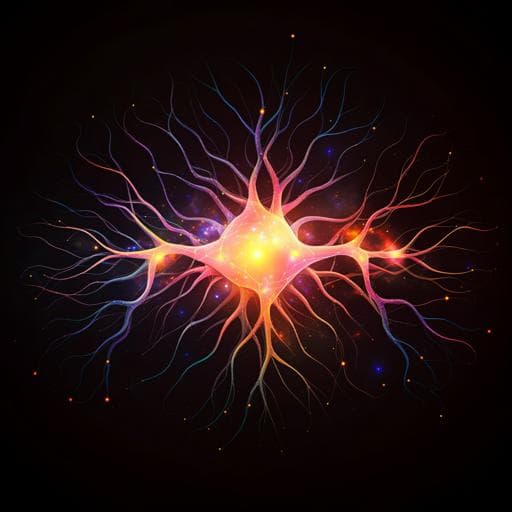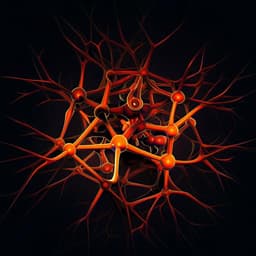
Psychology
Mutations associated with neuropsychiatric conditions delineate functional brain connectivity dimensions contributing to autism and schizophrenia
C. A. Moreau, S. G. W. Urchs, et al.
Uncover the startling link between copy number variants (CNVs) at 16p11.2 and 22q11.2 loci and neuropsychiatric disorders. This insightful study by authors including Clara A. Moreau and Sebastian G. W. Urchs delves into how these genetic variants influence brain connectivity, revealing dysconnectivity patterns that may shed light on cognitive and behavioral symptoms in conditions like ASD and SZ.
~3 min • Beginner • English
Introduction
Copy number variants (CNVs), comprising deletions or duplications of DNA segments, are a major source of rare genetic variation and increase risk for neurodevelopmental and psychiatric conditions, including ASD, SZ, and ADHD. Recurrent large-effect CNVs at 16p11.2 and 22q11.2 alter dosage of 29 and 50 genes, respectively, and substantially elevate risk for ASD, SZ, and ADHD. Prior imaging work suggests mirror effects of gene dosage on neuroimaging phenotypes and overlapping structural alterations with idiopathic psychiatric conditions, yet the mechanisms linking CNVs to functional connectivity (FC) and their relationship to idiopathic disorders are unclear. Resting-state FC reflects intrinsic synchronization across brain regions and aligns with spatial gene expression patterns. While some ROI-based studies in 22q11.2 and 16p11.2 carriers reported dysconnectivity, comprehensive connectome-wide analyses and cross-condition comparisons are lacking. The study hypothesizes that distinct genetic variants and idiopathic disorders share dysconnectivity patterns, revealing FC dimensions relevant to psychiatric conditions. Objectives: (1) characterize FC-signatures of 16p11.2 and 22q11.2 deletions/duplications; (2) test whether these CNV FC-signatures capture dimensions present in idiopathic ASD, SZ, or ADHD; (3) investigate relations between deletion FC-signatures and spatial gene expression.
Literature Review
Previous rs-fMRI studies in 22q11.2 deletion carriers reported thalamic-hippocampal dysconnectivity and default mode network (DMN) underconnectivity predictive of psychotic symptomatology, and disrupted long-range DMN connectivity. A 16p11.2 study found decreased fronto-temporo-parietal connectivity in deletion carriers. However, these were mainly ROI-based; no connectome-wide association studies (CWAS) had been performed in CNV carriers, nor were relationships to idiopathic conditions established. In idiopathic ASD, widespread underconnectivity with cortico-subcortical overconnectivity (notably thalamus) is reported. SZ shows general underconnectivity involving medial prefrontal, cingulate, temporal regions, and thalamic overconnectivity. These network alterations recur across diagnoses (ASD, ADHD, SZ), consistent with transdiagnostic dimensions and shared genetic contributions observed for common and rare variants, including 16p11.2 and 22q11.2 CNVs.
Methodology
Design and samples: Seven connectome-wide association studies (CWAS) were conducted across five datasets: (1) 16p11.2 deletion/duplication carriers and controls (Simons VIP); (2) 22q11.2 deletion/duplication carriers and controls (UCLA); (3) idiopathic ASD cases and controls (ABIDE, 10 sites); (4) SZ cases and controls (aggregated from 10 studies via SchizConnect); (5) ADHD cases and controls (ADHD-200, 7 sites). After preprocessing and QC, N=1,928 participants were included (CNV carriers n=101; idiopathic ASD n=225, SZ n=241, ADHD n=289; controls n=1,072). Ethics approvals and informed consent obtained. Imaging and preprocessing: Site-specific MRI acquisitions; uniform preprocessing with Neuroimaging Analysis Kit v0.12.4. Visual QC for co-registration, motion, artefacts. Connectome construction: Brain parcellated into 64 functional seed regions (MIST-64). FC computed as Fisher-transformed Pearson correlations between region-averaged time series, yielding 2,080 connections per individual (2,016 region-to-region, 64 within-region). Statistical analysis for CWAS: Within each cohort, FC was z-scored based on control variance. Linear regression per connection with z-scored FC as dependent variable and clinical status as predictor, adjusting for sex, head motion, and age. Two-tailed t-tests on β (status) estimates; Benjamini–Hochberg FDR correction at q<0.05 across 2,080 tests. Global FC shift defined as mean β across connections; significance assessed via 5,000-label-permutation CWAS. Mirror effects: Computed product of β from deletion vs control and duplication vs control; negative indicates mirror effects. Whole-brain and regional similarity analyses: Group-level FC-signatures (vector of 2,080 β values from case–control contrast) were correlated (Pearson r) with individual connectomes from other groups, testing case vs control differences (Mann–Whitney U), FDR-corrected across 42 tests. Regional analyses decomposed FC-signatures into 64 seed-level profiles; for each region, similarity scores (Pearson r) between regional β patterns and individual regional connectivity were compared between cases and controls (Mann–Whitney U), FDR across 64 regions. Behavior–similarity associations: In ASD, correlated similarity to deletion FC-signatures with ADOS and FSIQ; in SZ, with PANSS; FDR-corrected. CNV–CNV similarity: Cross-correlated deletion FC-signatures at regional level between 16p11.2 and 22q11.2 carriers. Gene expression alignment and analyses: Aligned Allen Human Brain Atlas expression (6 adult donors, 15,663 genes) to MIST-64 using abagen, with donor-wise normalization and averaging. For 16p11.2 (24 genes) and 22q11.2 (37 genes), used partial least squares regression (PLSR) to relate spatial gene expression to deletion FC-signatures (global and regional), assessing significance against 5,000 null FC-signatures (label-shuffled). Tested specificity via 10,000 random gene-set PLSRs matched in size. Also computed genome-wide Pearson correlations between individual gene expression and deletion FC-signatures, with genome-wide FDR. Software: Python (scikit-learn) and R; code available on GitHub.
Key Findings
- 16p11.2 deletion: Significant global increase in FC (mean shift = +0.29 z; p=0.048, permutation). 88 FDR-significant altered connections (all but one overconnected; β≈0.76–1.34). Overconnectivity mainly in frontoparietal, somatomotor, ventral attention, and basal ganglia networks; strongest regional effects in caudate, putamen, lateral frontal pole, anterior middle frontal gyrus, dorsal ACC. - 22q11.2 deletion: Non-significant global decrease; 68 FDR-significant underconnected links (β≈−0.68 to −1.64), predominantly in anterior/lateral DMN and limbic networks; strongest regional effects in temporal pole, ventral anterior/peri-insular regions, amygdala–hippocampal complex, dorsal and perigenual ACC. - 16p11.2 duplication: No individual connections survived FDR. - 22q11.2 duplication: 16 FDR-significant connections (overconnectivity) including posterior medial/lateral visual networks, cerebellum I–V, lateral fusiform gyrus; largest effect among these had Cohen’s d=1.87. - Mirror effects: Deletions vs duplications showed mirror effects at global level for both loci; at network level for 16p11.2 (p=0.006), not for 22q11.2. - Idiopathic conditions: SZ exhibited widespread underconnectivity (835 connections; overconnectivity in 24); ASD showed predominantly underconnectivity (73 under, 2 over); ADHD had no FDR-significant connections. Effect sizes were smaller in idiopathic groups: largest |β| SZ=0.56, ASD=0.46, ADHD=0.26, versus deletions (max β≈+1.34 for 16p11.2 and +1.64 for 22q11.2). - Cross-group FC similarity: Significant whole-brain FC-signature similarities were observed between CNVs (both deletions and, to a lesser extent, duplications) and idiopathic ASD and SZ; no significant similarities with ADHD. - Regional drivers: Thalamus, somatomotor, posterior insula, and cingulate regions drove CNV–ASD/SZ similarities. SZ showed increased similarity to 28 (16p11.2 del) and 18 (22q11.2 del) regional FC-signatures; ASD to six regions for each deletion. Thalamus FC-signatures of both deletions showed increased similarity in both ASD and SZ. - Symptom associations: In ASD, greater similarity to deletion FC-signatures correlated with more severe symptoms: ADOS and lower FSIQ; two regions (caudate nucleus, temporal pole) survived FDR for ADOS. No PANSS associations survived FDR in SZ. - CNV–CNV regional similarity: 12 regions (22q11.2 del signature vs 16p11.2 del carriers) and 10 regions (reverse test) showed significant similarity; overlapping in frontoparietal, ventral attention, somatomotor, DMN, and basal ganglia networks; four seed regions overlapped across tests. - Gene expression relationships: PLSR showed significant associations between spatial gene expression within CNV loci and deletion FC-signatures: for 16p11.2, two components explained 24.2% variance (p=0.041); for 22q11.2, one or two components significant (p<0.0002), two components explained 43.2%. Regionally, 18 (16p11.2) and 32 (22q11.2) seed-level FC-signatures were significantly associated with expression patterns; 11 regions overlapped across loci (including thalamus, dorsal ACC, caudate, insula, hippocampus/amygdala, visual networks). However, specificity was low: gene sets outside CNV loci often showed similar associations. Genome-wide, 421 (uncorrected) and 3,883 genes correlated with 16p11.2 and 22q11.2 FC-signatures respectively (vs random FC-signatures); after FDR, 1,834 genes remained correlated with 22q11.2 FC-signature, none with 16p11.2. Individual CNV genes with high correlations included MVP and KIF22 (16p11.2), and AIFM3, TBX1, P2RX6 (22q11.2).
Discussion
This study provides the first connectome-wide characterization of FC alterations in carriers of 16p11.2 and 22q11.2 deletions/duplications and relates them to idiopathic ASD, SZ, and ADHD. Deletions produced large, mirror-direction FC effects relative to duplications, with 16p11.2 deletion overconnectivity mainly in ventral attention, motor, and frontoparietal networks, and 22q11.2 deletion underconnectivity in anterior/lateral DMN and limbic networks. Despite smaller case–control effects in idiopathic cohorts, CNV FC-signatures showed significant similarities with ASD and SZ at whole-brain and regional levels, especially involving thalamus, somatomotor, posterior insula, and cingulate regions. These similarities were behaviorally relevant in ASD, where greater resemblance to deletion FC-signatures related to higher ADOS severity and lower FSIQ, suggesting that CNV-related FC dimensions capture clinically meaningful variance within idiopathic disorders. The convergence on thalamo-sensory dysconnectivity across CNVs and diagnoses aligns with core perceptual disturbances in SZ and ASD and with prior transdiagnostic rs-fMRI literature. Associations between FC-signatures and spatial gene expression within CNV loci support a transcriptomic underpinning; however, the widespread, redundant correlations across the genome indicate low specificity, potentially explaining shared FC features between different CNVs and idiopathic conditions. Together, results support a model in which rare high-impact mutations and idiopathic psychiatric disorders share intermediate FC phenotypes along continuous dimensions, with CNVs illuminating mechanistic building blocks (e.g., thalamo-sensory circuitry) that are necessary but insufficient for disease expression.
Conclusion
The study delineates robust FC-signatures of 16p11.2 and 22q11.2 CNVs, reveals mirror gene-dosage effects, and identifies shared connectivity dimensions with idiopathic ASD and SZ centered on thalamo-sensory, insular, and cingulate circuitry. Similarity to CNV deletion FC-signatures relates to greater symptom severity and lower cognitive performance in ASD. Spatial gene expression patterns within CNV loci associate with FC-signatures but exhibit redundancy genome-wide, offering a potential explanation for convergent FC phenotypes across different CNVs and diagnoses. These findings argue against studying psychiatric conditions or rare variants in isolation and instead advocate for large-scale, integrative designs that bridge top-down (across diagnoses) and bottom-up (across genomic variants) approaches to parse specific versus shared pathways. Future work should: (1) expand to additional CNVs and polygenic risk contexts; (2) incorporate developmental gene expression dynamics; (3) refine subtyping within idiopathic cohorts based on CNV-informed FC dimensions; and (4) test causal models linking gene dosage, transcriptomic gradients, FC alterations, and clinical phenotypes.
Limitations
- Reproducibility challenges in rs-fMRI; results align with literature when methodologies (e.g., global signal regression) are matched, but methodological choices can alter findings. - No genetic data in idiopathic cohorts; although 16p11.2/22q11.2 CNVs are rare (<1%), observed similarities likely arise from other genetic/environmental factors. - Gene expression derived from six adult brains (AHBA); developmental timing differences between ASD and SZ may limit relevance, possibly explaining stronger genome-wide correlations for 22q11.2 than 16p11.2. - Limited power for duplication analyses; fewer significant effects. - Restricted phenotypic data in SZ (no FSIQ), limiting behavior–FC analyses. - ADHD showed no significant similarities, potentially due to smaller effect sizes. - Potential confounds (sex bias, age differences, comorbid ASD/ADHD in 22q11.2 deletions, medication) were examined via sensitivity analyses and did not change main results, but residual confounding cannot be entirely excluded.
Related Publications
Explore these studies to deepen your understanding of the subject.







